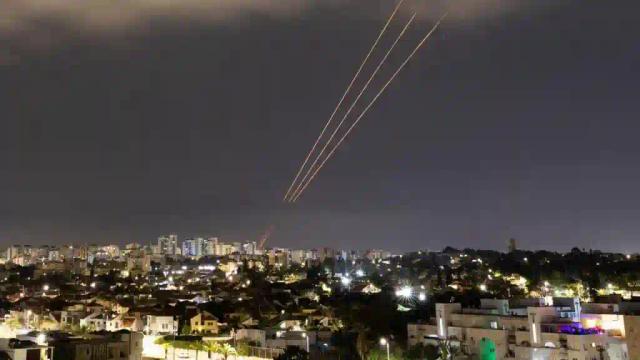Here Is Why And How Iran Attacked Israel

Iran directly attacked Israel for the first time on Sunday morning, in what is the largest ever drone strike in the world, and its biggest missile attack ever.
As reported by Al Jazeera, Iran used hundreds of drones and missiles to directly target Israel in retaliation for an Israeli strike on the Iranian consulate in Damascus, Syria, two weeks ago.
An Israeli air strike flattened the Iranian consulate in Damascus and killed two commanders from Iran’s Islamic Revolutionary Guards Corps (IRGC) and five other people.
Brigadier General Mohammad Reza Zahedi, a senior commander in the elite Quds Force of the IRGC and his deputy General Mohammad Hadi Hajriahimi were killed in the Israeli attack.
The two generals were in charge of leading operations in Syria and Lebanon.
HOT DEALS:
itel A70 - (128GB, 3GB RAM) $89,
itel A70 - (256GB, 4GB RAM) $99
itel P40 (128GB, 4GB), (6000mAh) $99
itel P40 (64GB, 4G), (6000mAh) $93
Cash on Delivery in Harare & Bulawayo. Tinotumira kwamuri inosvika.
WhatsApp: 0783 450 793
Iran’s attack on Israel on Sunday was the single largest drone attack ever carried out by any country, and it was the first time Iran directly attacked Israel.
Operation “True Promise” was mainly aimed at strengthening Iran’s deterrence, which critics said had been compromised after increasingly confrontational policies and military strikes by the United States and its allies across the region, reported Al Jazeera.
The attack, despite briefly shifting the world’s attention from the deaths of tens of thousands of women and children in the Gaza Strip, could translate into soft power gains for Iran in the Muslim world in the long run, when compared with other regional powers.
Iran would also justify its actions at the United Nations Security Council since attacks on diplomatic missions signal a violation of the Vienna Convention.
Furthermore, Article 51 of the UN Charter enshrines the “inherent right” of self-defence, something Israel has been heavily leaning on since the start of the Gaza war.
As of Sunday, Iran had not officially confirmed the exact number of drones or ballistic and cruise missiles it used to attack Israel, but the Israeli military said more than 300 were launched.
As reported by the Guardian, Israel’s military said all 170 drones launched from Iran, likely to be from its Shahed family, were shot down before they reached Israeli airspace.
The drones are not much threat, able only to carry a modest bomb of up to 50kg, but they intend to tie up defenders.
Videos of the craft circulated on social media hours before being shot down, gave those responding plenty of time to react.
The drones’ noisy engines suggested they were the slow-flying Shahed-136, which would take six hours to fly from Iran to Israel.
However, some Israeli media reported Iran had launched the faster jet-engined Shahed 238, which travels three times more quickly.
The spokesperson of Isreal’s military, Daniel Hagari, said Iran also launched 30 cruise missiles towards its territory, with IDF jets intercepting 25 “outside the country’s borders”.
The missiles are most probably the newly designed Paveh-351, designed to be manoeuvrable in flight but still take two hours from Iran.
More than 120 high-speed ballistic missiles, capable of flying several times the speed of sound and making the journey from Iran to Israel (about 600 miles at the closest points) in less than 15 minutes, were launched at Israel.
Hagari said that “a few” crossed into Israel’s airspace, some striking at the Nevatim airbase.
Israel’s air defence system’s Arrow 2 and Arrow 3 systems, manufactured in an Israeli-US collaboration, supported by David’s Sling, a medium-range interceptor, were deployed to hit the Iranian ballistic missiles.
The United States said it had knocked out about 70 drones and three missiles. The UK prime minister, Rishi Sunak, added that the British airforce had intercepted an unspecified number. Jordan, a longstanding US ally, reportedly shot down dozens more drones over its airspace that Iran had launched towards Israel.
Brig Gen Reem Aminoach, a former financial adviser to the IDF chief of staff, told Israel’s Ynet News that an Arrow missile typically costs $3.5m (£2.8m) a time, and David’s Sling interceptors $1m (£800,000).
He estimated that adding up the cost of eliminating 100 ballistic missiles, plus the costs of the whole air defence campaign, is “an order of magnitude of 4 to 5 billion shekels (£850m to £1.1bn)”.
However, the attack was also expensive for Iran, with ballistic missiles generally costing upwards of £80,000.
Following the attack, the Rial, Iran’s falling national currency, dropped to a new all-time low of about 670,000 per US dollar on Sunday before regaining some ground.
Iran’s chief of general staff, Gen Mohammad Bagheri, said on Sunday that the operation was considered a success and further attacks on its part were not necessary.
More: Pindula News





